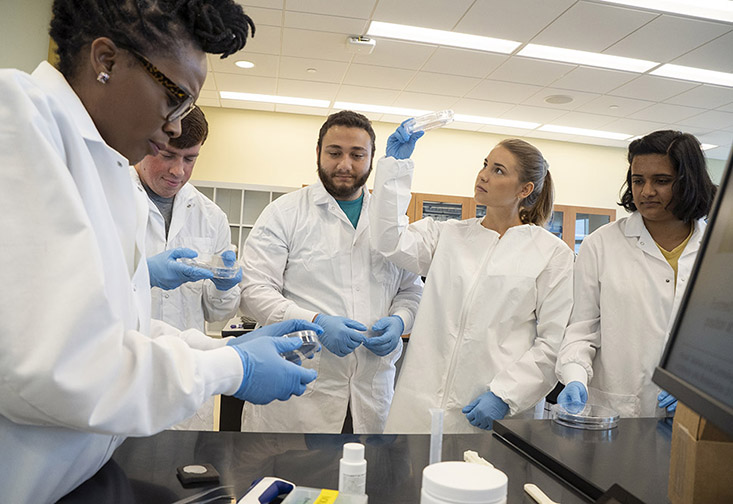Individual Learning for High-demand Fields

Biomedical engineering’s first cohort of five students learn about the mechanical properties of biomaterials. (Left to right: Blake Sanborn, Arsany Gad, Rachel Llewellyn, Deena Bhula)
October 2, 2019 | University News
Atop USF’s tallest building, five students and one instructor huddle inside one of the newest state-of-the-art Biomedical Engineering (BME) labs. With plenty of space and time to go over the class lecture and lab activities, students are able to learn more quickly and develop stronger career-shaping relationships.
“It makes a big difference,” said Rachel Llewellyn, a BME senior. “A lot of the professors have had many experiences besides being a professor, so we can hear the different walks of life as we are about to embark on our own career path.”
Nearly 45 percent of USF courses have fewer than 20 students. Lower student-to-faculty ratios are of great importance to USF as smaller classes produce more well-rounded students. For faculty, it’s an opportunity to support unique learning competencies adequately.
“Faculty can consistently provide detailed feedback on individual students thereby enhancing their learning,” said Olukemi Akintewe, PhD,BME faculty.
Akintewe says there is a quicker turnaround rate on assignments and exams, which helps to reinforce current lesson plans. Small classes have increased student engagement and so there is a heightened sense of community.
“Students are more likely to ask questions in smaller classes, this could be due to less peer pressure,” said Akintewe.
The BME program is pioneering interdisciplinary work between the College of Engineering and the Morsani Medical College of Medicine. Medical research and industry is fast-growing in Tampa, partly due to the downtown medical building set to open later this year. The first BME cohort will be particularly prepared to collaborate as biomedical engineers.
Lewellyn, one of the first five students expected to graduate Spring 2020, says ethics is an area that will be defined by transdisciplinary communication since “we [biomedical engineers] may talk about some things that others don’t.”
Robert Frisina, PhD, BME founding director, says the new department provides mechanisms for engineering students to work more directly with doctors and medical school faculty.
“Avenues are being formed for medical students and residents to interact more closely with engineering students and faculty for novel research and innovation projects,” said Frisina.
High-demand fields are strongly considered when the university hires new faculty and establishes class sizes. With the national nursing shortage and the growing need to educate more students for the profession, the College of Nursing strategically breaks students into small groups so that they can provide the best learning experience.
“It is really helpful to be able to have that time and attention to express your concerns when you feel like you’re not really getting something or you feel like you need to be able to do it again,” said Candace Clayborne-Harris, a nursing student in the accelerated second bachelor's program.
In a recent a requirement to acquire hospital privileges, Clayborne-Harris said she needed extra help to learn how to insert a foley. This procedure carries a high infection rate if not inserted properly.
Clayborne-Harris said the small class size “ensures that we have those skills down.”
USF’s rise in national rankings and reputation is attributed to many key academic areas both inside and outside the classroom.


